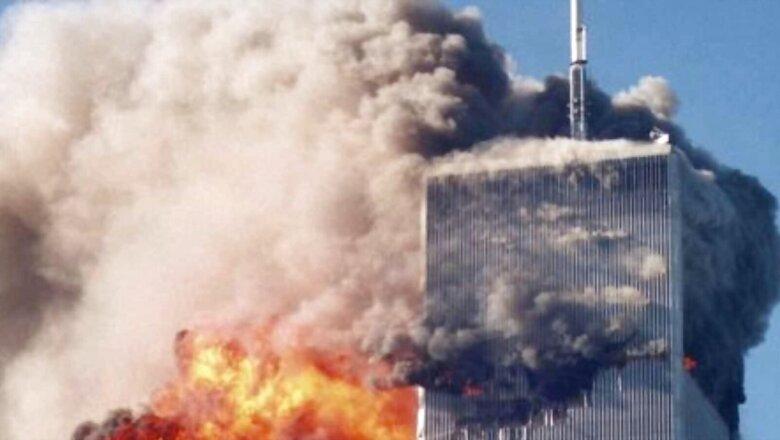
views
For Americans September 11, 2001, has been etched in their memories as the day when New York’s two tallest buildings were reduced to rubble within three hours. It was a coordinated hijacking of four commercial airplanes, which were then used to fly into high-profile targets in New York City and Washington, DC.
The deadliest terrorist attack in the history of the United States of America marks its 20th anniversary this year. This timeline traces the events that led to a heightened suspicion of non-Americans in the US, increased government efforts to address terrorism, and a more aggressive foreign policy.
September 11, 2001: Terrorists Bring Down the USA
In the early hours of September 11, 2001, a total of 19 hijackers made their way through security at airports in Boston, Newark, and Washington, DC. The attacks began around 8 am when a lone plane smashed into the World Trade Center in New York followed by a second plane. Then a third plane crashed into the Pentagon, the nerve center of the American armed forces leaving it burning and partially collapsed. Then a fourth plane was downed in Pennsylvania.
The attacks killed 2,977 people from 93 nations. 2,753 people were killed in New York, 184 people were killed at the Pentagon while 40 people were killed on Flight 93. The 9/11 terrorists were members of Islamist extremist group al-Qaeda who planned the attacks from their base in Afghanistan.
The collapse of America’s most symbolic twin towers came as a collective shock to the entire world who were still struggling to make sense of how a coordinated act of terrorism of that magnitude was allowed to take place on American soil.
The period following the attack was one which saw an aggressive foreign American policy being implemented. President George W Bush pledged to win the war against terrorism and also decided to be down al-Qaeda and Osama bin Laden, the mastermind behind the attacks.
Economic Impact of 9/11
The market saw a sharp decline of 7.1% on the first day of trading following the attacks. Nearly 143,000 jobs were lost in a month in New York alone. The heaviest losses were in finance and air transportation which accounted for 60% of lost jobs.
President Bush Commissions the Formation of Department of Homeland Security
A week after the 9/11 attacks, letters containing anthrax spores were sent to the offices of several media houses including The New York Post and NBC killed 2 and leaving 17 infected. This acted as the last straw after which President George W. Bush commissioned the formation of the Department of Homeland Security. While commissioning the formation of the DHS, he was clear about the news agency’s top goal, to be ‘one department whose primary mission is to protect the American homeland’. In other words, to prevent another foreign attack on American soil. 20 years after the attacks, DHS is now the third-largest federal agency, with nearly 230,000 employees, and is most visible for its role in enforcing immigration laws at the southern border.
9/11 War Authorization
The Authorization for Use of Military Force (AUMF) was a joint resolution of the United States Congress which became law on September 18, 2001, authorizing the use of the United States Armed Forces against those responsible for the September 11 attacks. The authorization granted the President the authority to use all “necessary and appropriate force” against those whom he determined “planned, authorized, committed or aided” the September 11 attacks, or who harbored said persons or groups.
War on Taliban in October 2001
The U.S. military, with the help of British support, begins a bombing campaign against Taliban forces. Canada, Australia, Germany, and France pledge future support. The war’s early phase involves U.S. airstrikes on al-Qaeda and Taliban forces that are assisted by a partnership of about one thousand U.S. special forces, the Northern Alliance, and ethnic Pashtun anti-Taliban forces. Al-Qaeda leader Osama bin Laden is tracked down into the Tora Bora cave complex southeast of Kabul but he escapes after engaging in a fierce 2-week battle.
December 9, 2001: Taliban Regime Collapses
Following the fall of Kabul in November 2001, the United Nations invites major Afghan factions, most prominently the Northern Alliance and a group led by the former king, to a conference in Bonn, Germany. On December 5, 2001, the factions sign the Bonn Agreement which installs Hamid Karzai as interim administration head and creates an international peacekeeping force to maintain security in Kabul. Taliban leader Mullah Omar flees the city, leaving it under tribal law administered by Pashtun leaders while al-Qaeda leaders continue to seek refuge in the mountains.
President Bush Calls for Reconstruction of Afghanistan
On April 17, 2002, President George W. Bush calls for the reconstruction of Afghanistan in a speech at the Virginia Military Institute. “By helping to build an Afghanistan that is free from this evil and is a better place in which to live, we are working in the best traditions of George Marshall,” he says, evoking the post-World War II Marshall Plan that revived Western Europe.
‘End of a Major Combat’
Secretary of Defense Donald Rumsfeld declares an end to major combat. The announcement comes along with President George W Bush’s ‘mission accomplished’ declaration of an end to fighting in Iraq leaving almost 8,000 US soldiers stationed in Afghanistan.
Karzai Becomes First Afghan President
In historic national balloting in 2004, Karzai becomes the first democratically elected head of Afghanistan. Voters turn out in high numbers despite threats of violence and intimidation. Karzai wins with 55 percent of the vote, while his closest rival, former education minister Younis Qanooni, polls 16 percent.
Bin Laden Reappears
In 2004, October, Osama bin Laden releases a videotaped message three weeks after the country’s presidential election and just days before the U.S. polls. In the video aired on the Arab television network Al Jazeera, bin Laden taunts the Bush administration and takes responsibility for the attacks of September 11, 2001. “We want to restore freedom to our nation, just as you lay waste to our nation,” bin Laden says. Following which Afghan President Hamid Karzai and U.S. President George W. Bush issue a joint declaration that pronounces their respective countries’ strategic partners. The declaration gives U.S. forces access to Afghan military facilities to prosecute “the war against international terror and the struggle against violent extremism.”
In 2009 Obama Recommits to Afghanistan, Introduces New American Strategy
New U.S. President Barack Obama announces plans to send seventeen thousand more troops to the war zone. He says the United States will stick to a timetable to draw down most combat forces from Iraq by the end of 2011. President Obama announces a new strategy for the war effort, the core goal of which is “to disrupt, dismantle, and defeat al Qaeda and its safe havens in Pakistan, and to prevent their return to Pakistan or Afghanistan.”
Osama Bin Laden Killed
On May 1, 2011, al-Qaeda leader Osama bin Laden, responsible for the 9/11 attacks in New York and Washington, is killed by U.S. forces in Pakistan. As President Obama prepares to announce the withdrawal of some or all of the thirty thousand surge troops in July, congressional lawmakers increasingly call for a hastened drawdown of U.S. troops, though some analysts argue for a sustained military engagement.
Obama Announces Troop Drawdown
President Barack Obama announces a timetable for withdrawing most U.S. forces from Afghanistan by the end of 2016. The first phase of his plan calls for 9,800 U.S. troops to remain after the combat mission concludes at the end of 2014.
Trump Signals Prolonged Afghan War
President Trump outlines his Afghanistan policy in an address to troops in Arlington, VA, saying that though his “original instinct was to pull out,” he will instead press ahead with an open-ended military commitment to prevent the emergence of “a vacuum for terrorists.”.
Biden decides on complete US withdrawal from Afghanistan
President Biden releases a plan for a full withdrawal by September 11, 2021. “It’s time to end America’s longest war,” he says. Biden says Washington will continue to assist Afghan security forces and support the peace process.
Afghan Government Collapses as the Taliban Takes Kabul
Taliban militants capture the capital, Kabul, and take over the presidential palace hours after President Ghani leaves the country. Taliban leaders say they will hold talks with Afghan officials to form an “open, inclusive Islamic government.” Former Afghan President Karzai and Abdullah, formerly the chief executive under Ghani, create a council to facilitate a peaceful transition to a Taliban government.
Read all minute-by-minute news updates for Uttar Pradesh election results 2022, Punjab election results 2022, Uttarakhand election results 2022, Manipur election results 2022, and Goa election results 2022.
Click here for seat-wise LIVE result updates.



















Comments
0 comment